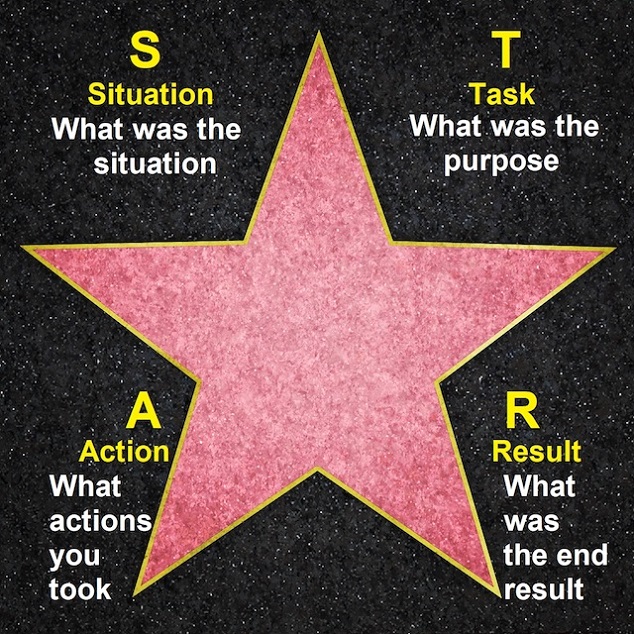The STAR Method to Prepare for Interview Questions

Preparing for an interview doesn’t need to be a nerve-wracking experience. You want to put your best foot forward and impress the interviewer. Of course, there will be questions, but you don’t know what kinds of questions you will get. Here comes the STAR Method to help you out with an organized way to answer your interview questions – especially the behavioral interview questions.
The Most Common Interview Questions
The most common interview questions are usually behavioral ones. Behavioral interview questions require you to provide an example of how you handled a particular work situation that arose in your previous job. It lets the interviewer assess whether you have the experience and/or skills for the job you are interviewing for.
Why? According to career development director and associate publisher at Quintessential Careers, Katharine Hansen, Ph.D., behavioral interview methods can accurately predict the future behavior of an employee 55% of the time, compared with 10% for traditional interview questions. This is why so many hiring managers turn to behavioral interviewing to ensure a good match between new employees and their companies.
So how do you spot behavioral questions during an interview? They are quite simple to spot: most common behavioral interview questions usually begin with:
Can you give me an example of…
Tell me about a time when….
Have you ever…
What did you do when…
Can you describe…
How do you go about….
Unfortunately, there is no way for you to know beforehand which type of behavioral interview question you will be asked. One of the most important things to do is to brainstorm before you go for your interview, select a few suitable examples of your previous work and life experiences, and adapt them to the questions you get asked.
The other important thing is to know how to answer them. Here’s where the STAR interview method can help you respond to interview questions without going off on a tangent or rambling on about unrelated topics. This is particularly important because, according to a survey by Scribd, 76% of hiring managers say an “interesting” candidate is one of the main traits they look for during an interview.
The Star Method or Star Technique to Prepare for Behavioral Interview Questions?
The STAR interview method enables you to answer common interview questions about a previous situation at work in a compelling, meaningful way. Your answers can be structured according to specific Situations, Tasks, Actions, and Results.
 | Situationdescribe the event, and give the necessary details of the situation Taskwhat was your role in that situation, or what was the purpose? Actiondescribe what you did to address or resolve that situation Resultdescribe the outcome |
Breaking your answer down into these components makes it easy to give a focused answer and provide the interviewer with a concise, intelligent narrative of your reaction to a given situation.
Your answer not only allows the interviewer to determine if you are a correct fit for the job but also makes you come across as someone who can think clearly under pressure, possibly giving you bonus points and tipping the odds for getting the job in your favor.
The STAR method: Step-By-Step
Bear in mind that the STAR interview method will only work if you share a story about your previous work experience relevant to the question. That is the crucial starting point. It is ok to pause for a few seconds to compose yourself. Don’t be afraid to ask the interviewer for a moment to think about your answer.
When you are ready, set the scene with the necessary details. The keyword here is necessary – you don’t have to include any extraneous details, especially when you might (naturally) be feeling nervous and under pressure.
Situation
Describe, in straightforward terms, the situation you were in. Include what the problem was. The STAR method is designed to be simple, so there’s no need to provide too much detail, start rambling, and possibly losing your train of thought.
A good rule of thumb to prevent this happening is to focus on using just one or two sentences for each step of your STAR answer.
For example, if the interviewer asks you, “Can you tell me about a time when you had to accomplish a task with a colleague who was difficult to work with?” Using the “STAR method”, your answer could begin with, “The other programmer I was working with always had to do things his way.”
Task
Describe what you were doing. There’s no need to embellish here, because you run the risk of coming across as boastful. It is enough to say something like: “We had to collaborate on a two-month project for a big client.”
Action
What did you do to resolve the situation? The right kind of answer could go something like this: “I found that if I listened without judgment, he did have some excellent ideas, but sometimes if I felt strongly enough about something, I’d put my ideas across in a non-confrontational way, and I found that he was willing to listen. I realized he was a very talented programmer who had earned the reputation of being difficult because he worked twice as fast as anyone else and could get impatient sometimes.”
Result
Now you summarize the positive outcome of your actions in the situation. The anecdote you have chosen to relate has a positive outcome. No interviewer will be impressed with a story that ends with “And then they fired me”!
Just a simple summary will do: “We managed to get the project completed ahead of time. By listening more, I also learned a lot from this guy.”
The STAR method works for almost all behavioral-based interview questions. It may seem overwhelming at first, but practice is key to answering these questions. Pick a few situations in your work life that have had positive outcomes, and practice your answer out loud in front of a mirror, and talk it through with yourself or a friend until it sounds natural to you. You can also get a professional recruitment agency to help you practice answering interview questions. This is just one of the ways a recruiter can help you land your next job.
Follow these tips, and you might even look forward to getting behavioral questions during interviews – after all, they are a great chance for you to highlight how great you would be for the job!

After graduating from the State University of New York, Naoko accumulated 14 years of experience in multinational companies’ diverse fields like HR, accounting, and sales support. She is a co-founder of ReachExt K.K. and EJable.com.